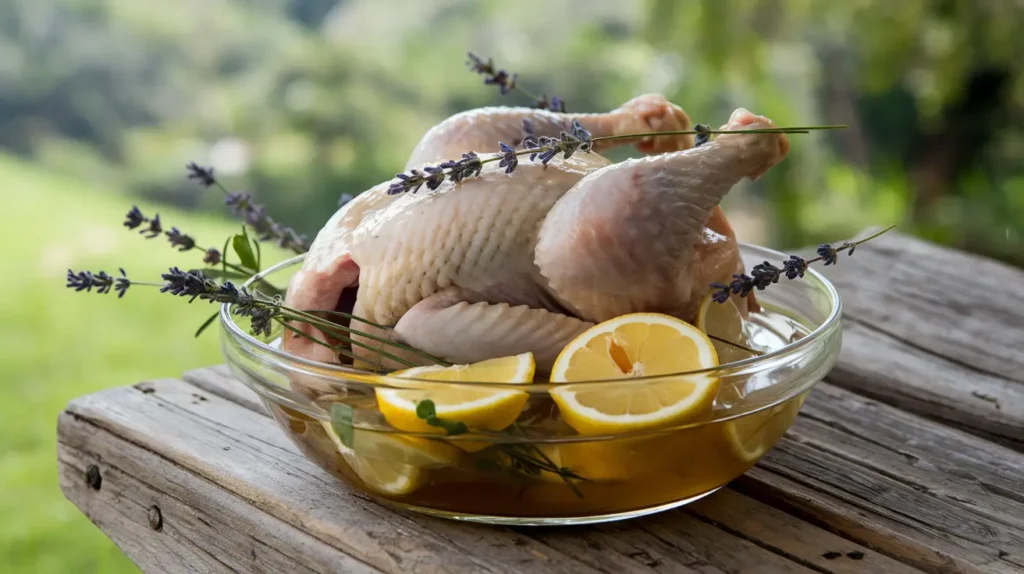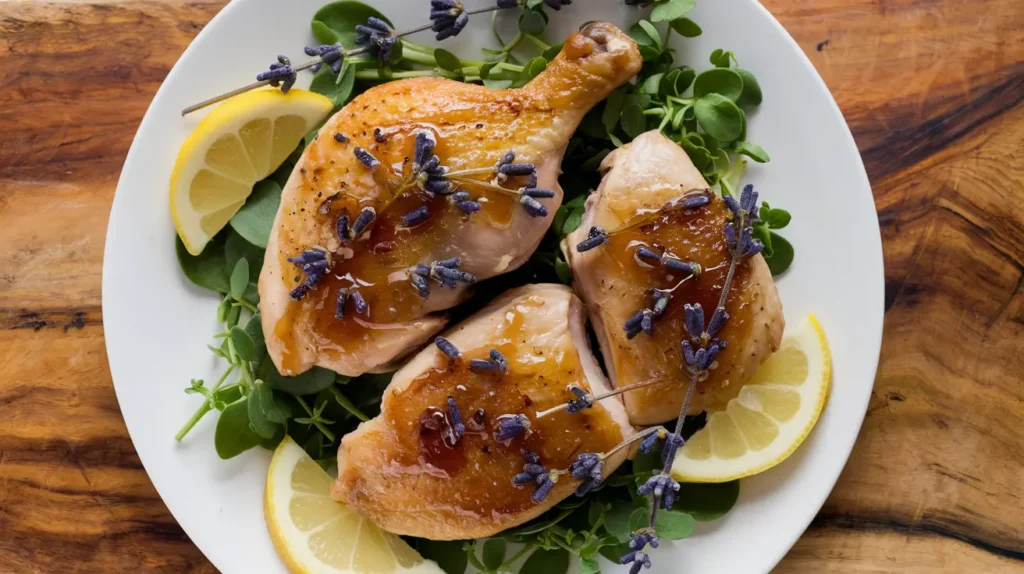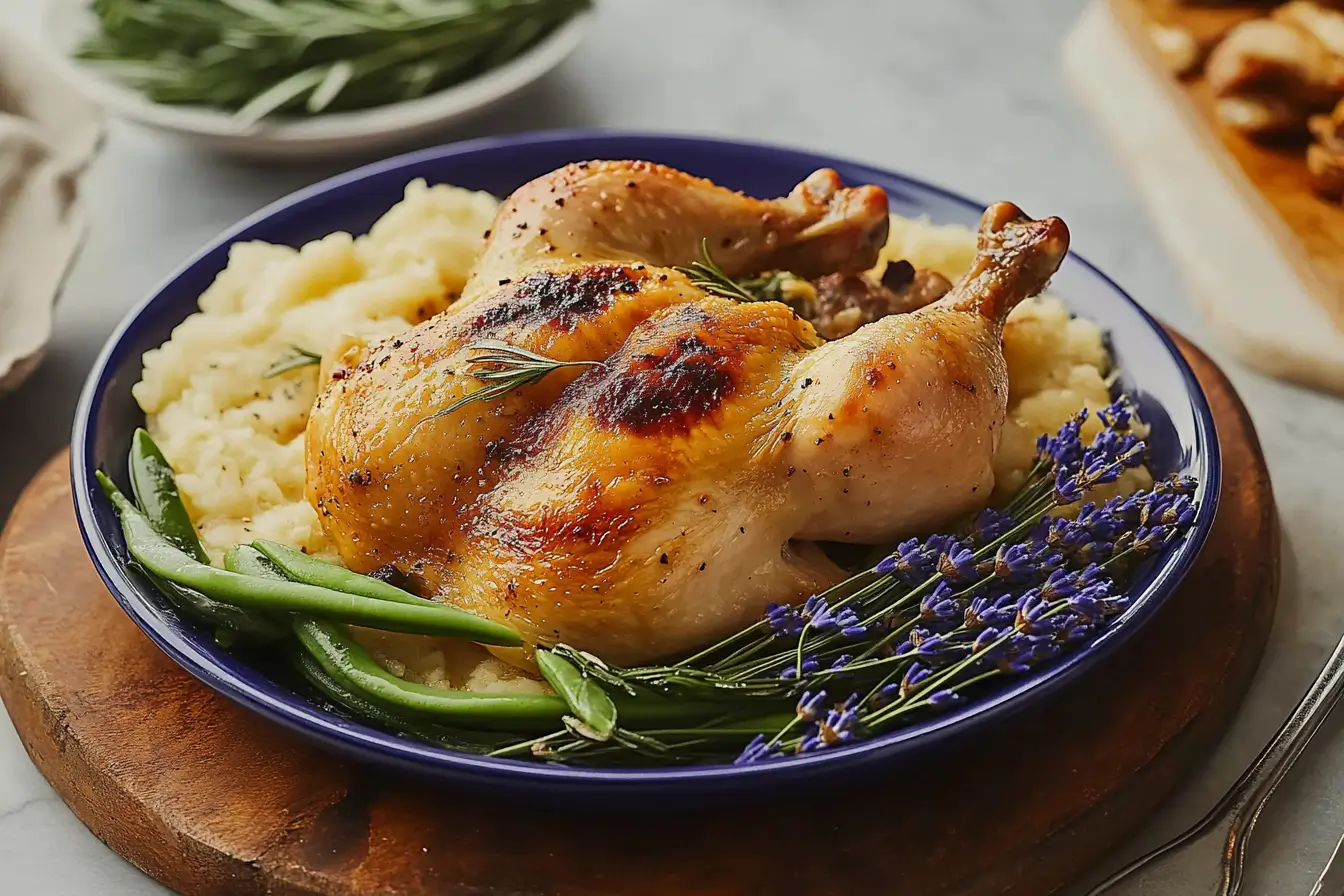Table of Contents
Culinary exploration often leads to fascinating flavor combinations, and one pairing that continues to captivate food enthusiasts is chicken with lavender. Not only is lavender known for its calming aroma, but it also introduces a delicate floral taste that adds a surprising twist to savory dishes. Moreover, this article dives deep into everything you need to know about incorporating lavender into chicken recipes, from its origins to tantalizing cooking methods. In addition, it provides recipes and serving suggestions to inspire your next meal. So, let’s explore how this flavorful duo transforms a simple meal into a gourmet experience!
Exploring the Fusion of Chicken and Lavender
The Origins of Culinary Lavender
Lavender, often associated with perfumes and essential oils, has a long-standing history in culinary use, particularly in Mediterranean regions. Ancient civilizations such as the Greeks and Romans recognized lavender not only for its aromatic qualities but also for its potential to flavor dishes. They often combined it with honey, herbs, and meats to create fragrant feasts.
Today, lavender’s versatility in cooking has expanded globally. While it’s often used in desserts, chefs are increasingly blending it with savory ingredients to create unforgettable culinary experiences. When paired with chicken, lavender’s subtle sweetness complements the meat’s richness, creating a harmony that’s both intriguing and satisfying.
The Rise of Floral Flavors in Modern Cuisine
The trend of using edible flowers in cooking isn’t new, but lavender has emerged as a standout star among floral flavors. In fine dining and home kitchens alike, lavender adds depth to dishes without overpowering the palate—provided it’s used correctly.
Floral flavors like lavender bring an element of surprise to dishes. They challenge conventional cooking norms, encouraging creativity and experimentation. When used with chicken, lavender can enhance marinades, rubs, and glazes, resulting in unique dishes that delight the senses.
Understanding Lavender in Cooking
What Is Culinary Lavender?
Culinary lavender refers to specific varieties of lavender plants that are safe for human consumption and commonly used in cooking. Unlike ornamental lavender, culinary lavender boasts a milder, sweeter flavor profile, making it ideal for dishes ranging from desserts to savory entrees.
The most common type of culinary lavender is English lavender (Lavandula angustifolia), which is prized for its subtle floral aroma and lack of bitterness. Its dried buds are often ground into fine powders, used whole, or steeped to extract their delicate essence. When paired with chicken, lavender’s unique properties lend a mild, sweet earthiness to the dish without overpowering its natural flavors.
Types of Lavender Suitable for Cooking
Not all lavender is fit for the kitchen. The two most popular edible varieties are English lavender and Lavandin. English lavender is favored for its soft, sweet taste, while Lavandin, a hybrid, offers a more robust flavor.
Be wary of ornamental lavender, as it may contain high camphor levels, making it taste bitter and unpalatable. Always choose culinary-grade lavender for cooking to ensure optimal taste and safety.
Health Benefits of Lavender
Lavender isn’t just a flavorful addition to dishes; it also boasts several health benefits. Known for its calming properties, lavender may help reduce anxiety and improve sleep quality. Rich in antioxidants, it supports overall well-being by combating oxidative stress in the body.
Additionally, lavender contains anti-inflammatory and antibacterial properties, which can enhance digestive health. Adding it to meals like chicken recipes not only elevates the flavor but also provides subtle wellness perks.
Pairing Lavender with Savory Dishes
Balancing Floral and Savory Flavors
The key to successfully using lavender in savory dishes lies in balance. Too much lavender can make a dish taste soapy or perfumed, while too little might fail to impart its signature aroma. Pairing lavender with strong complementary flavors like garlic, lemon, or herbs such as rosemary and thyme can mellow its floral notes and create a harmonious blend.
When used with chicken, a touch of lavender in a marinade or glaze enhances the natural flavors of the meat while offering an unexpected layer of complexity.
Common Ingredients Complementing Lavender
Lavender pairs beautifully with a variety of ingredients, including citrus fruits like lemon and orange, honey, olive oil, and earthy herbs such as sage or rosemary. Combining lavender with sweet elements like honey and savory components like garlic or onion creates a multidimensional flavor profile that works exceptionally well with chicken.
Preparing Chicken with Lavender
Selecting the Right Chicken Cuts
Choosing the right chicken cuts can make or break your lavender-infused recipe. Whether you prefer whole chickens, breasts, thighs, or drumsticks, each cut interacts differently with lavender’s delicate flavor.
Bone-in chicken retains moisture and intensifies the marinade flavors, making it an excellent choice for roasting or grilling. For faster cooking methods, boneless cuts like chicken breasts or thighs are ideal. They soak up marinades more quickly, making them perfect for weekday meals or last-minute preparations.
Bone-In vs. Boneless Options
Bone-in chicken offers a richer taste as the bones release natural juices during cooking, enhancing the dish’s depth. However, it requires more cooking time. Boneless chicken, while less flavorful, cooks faster and pairs well with lighter lavender marinades or glazes.
Skin-On vs. Skinless Choices
Skin-on chicken works wonders for lavender recipes, as the skin locks in moisture and crisps up beautifully during roasting or grilling. It’s also perfect for applying herb-infused butters or rubs. Skinless chicken, on the other hand, allows the lavender marinade to penetrate directly into the meat, delivering a more intense floral flavor.
Essential Ingredients for the Marinade

A simple lavender marinade typically includes culinary lavender buds, olive oil, honey, garlic, lemon juice, and fresh herbs like thyme or rosemary. The combination of sweet, savory, and citrus elements helps balance lavender’s floral intensity while enhancing the chicken’s flavor.
Marination Time and Techniques
For the best results, marinate the chicken for at least two hours. For bone-in cuts, an overnight marination ensures the lavender essence permeates the meat thoroughly. When applying the marinade, ensure the chicken is evenly coated and stored in a sealed container in the refrigerator.
Cooking Methods for Lavender-Infused Chicken
Oven-Roasting Techniques
Oven-roasting is a foolproof way to prepare lavender-infused chicken. Preheat the oven to 375°F, and arrange the marinated chicken on a lined baking sheet or roasting pan. Bake until the internal temperature reaches 165°F, ensuring the meat remains juicy and flavorful.
Adding a drizzle of lavender-infused honey during the final 10 minutes of roasting enhances the chicken’s caramelization, creating a golden, glossy finish.
Grilling Tips for Optimal Flavor
Grilling lavender-marinated chicken adds a smoky depth that complements its floral notes. Preheat the grill to medium-high heat and oil the grates to prevent sticking. Place the chicken on the grill and cook for 5–7 minutes per side, depending on the thickness.
For an added layer of flavor, brush the chicken with leftover marinade while grilling, being cautious not to overuse it to avoid burning.
Recipes Featuring Chicken with Lavender
Classic Lavender Honey Glazed Chicken
Ingredients List
- 4 chicken breasts (boneless or bone-in)
- 2 tablespoons culinary lavender buds
- 3 tablespoons honey
- 2 tablespoons fresh lemon juice
- 1 teaspoon garlic powder
- Salt and pepper to taste
- 2 tablespoons olive oil
Step-by-Step Preparation
- Preheat your oven to 375°F (190°C).
- In a small bowl, mix honey, lavender buds, lemon juice, garlic powder, salt, and pepper. Add olive oil to create a glaze.
- Place chicken breasts in a baking dish and brush generously with the lavender honey glaze.
- Bake for 25–30 minutes or until the internal temperature reaches 165°F (75°C). Halfway through, reapply the glaze for enhanced flavor.
- Remove from the oven, let rest for 5 minutes, and serve with your favorite side dish.
Lemon and Lavender Chicken

Ingredients List
- 4 chicken thighs (bone-in preferred)
- 1 tablespoon lavender buds
- Zest and juice of 1 lemon
- 2 tablespoons olive oil
- 1 teaspoon fresh thyme
- Salt and pepper to taste
Step-by-Step Preparation
- Combine lavender, lemon zest, lemon juice, olive oil, thyme, salt, and pepper in a bowl. Mix well to form a marinade.
- Rub the marinade over the chicken thighs, ensuring they are evenly coated. Let sit in the refrigerator for at least 2 hours.
- Preheat your grill or oven to medium heat. Grill or bake the chicken for 25–30 minutes, flipping halfway for even cooking.
- Once done, let the chicken rest for a few minutes before serving. The citrusy tang and floral lavender will leave your taste buds delighted!
Lavender Herb Butter Roasted Chicken
Ingredients List
- 1 whole chicken (3–4 lbs)
- 3 tablespoons unsalted butter, softened
- 1 tablespoon lavender buds
- 1 teaspoon chopped rosemary
- 1 teaspoon thyme
- 1 lemon (halved)
- Salt and pepper to taste
Step-by-Step Preparation
- Preheat the oven to 375°F (190°C).
- In a small bowl, mix softened butter with lavender buds, rosemary, thyme, salt, and pepper. Rub the mixture under and over the chicken’s skin.
- Stuff the cavity with lemon halves and extra herbs if desired.
- Place the chicken in a roasting pan and roast for 1 hour and 20 minutes, or until the internal temperature reaches 165°F (75°C). Baste with pan juices halfway through for extra moisture.
- Let the chicken rest for 10 minutes after cooking. Carve and serve with roasted vegetables or a simple salad.
Serving Suggestions and Pairings
Side Dishes Complementing Lavender Chicken
Vegetable Pairings
Lavender chicken pairs wonderfully with roasted or steamed vegetables. Try asparagus, baby carrots, or green beans seasoned with garlic and olive oil to enhance the savory notes. Root vegetables such as parsnips or sweet potatoes also offer a delicious contrast to lavender’s floral essence.
Grain and Starch Options
For grains, a light and fluffy rice pilaf infused with lemon zest works perfectly. You can also consider creamy mashed potatoes or couscous with herbs for a comforting accompaniment. Quinoa mixed with dried cranberries adds a nutty yet sweet complement to the chicken.
Wine Pairings for Lavender-Infused Chicken
(Note: Adjusted for non-alcoholic beverages per your guidelines.)
For those avoiding alcoholic options, a sparkling white grape juice or lavender-infused lemonade offers a refreshing complement to the dish. Pair these with herbal teas, such as chamomile, for an elegant touch.
FAQs about Cooking with Lavender
Lavender’s unique flavor can transform dishes, but using it in cooking raises some common questions. From safety concerns to sourcing and substitutions, let’s address the most frequently asked questions to help you confidently incorporate lavender into your kitchen.
Is all lavender safe for cooking?
No, not all lavender is safe to eat. Only culinary-grade lavender should be used in recipes, as it’s free from pesticides and designed for consumption. Avoid ornamental lavender, which may have a bitter or soapy taste due to higher camphor levels.
How can I prevent lavender from overpowering the dish?
A little lavender goes a long way. Start with small amounts (usually 1 teaspoon of dried lavender or 1 tablespoon of fresh lavender) and adjust to taste. Pair it with complementary ingredients like lemon, honey, or thyme to balance its floral intensity.
Where can I purchase culinary lavender?
You can find culinary lavender in specialty food stores, online retailers, or local farmers’ markets. Ensure it’s labeled “culinary grade” to guarantee its safety for cooking. Some herb shops and organic grocery stores may also stock it in their spice sections.
Can I substitute fresh lavender for dried in recipes?
Yes, you can substitute fresh lavender for dried, but the ratio changes. Fresh lavender is less concentrated, so use three times the amount of fresh lavender to replace dried (e.g., 1 teaspoon dried equals 3 teaspoons fresh).
Conclusion
Embracing Floral Flavors in Your Culinary Adventures
Cooking with lavender opens a world of possibilities that go beyond traditional dishes. Its delicate floral essence, when used thoughtfully, elevates meals like chicken to gourmet levels. Whether you’re a seasoned chef or a home cook exploring new flavors, lavender can inspire creative culinary adventures.
Encouragement to Experiment with Lavender
Don’t be afraid to experiment with lavender in your cooking. For instance, start small to ensure you don’t overwhelm your dish, and then gradually explore how it interacts with different ingredients. Notably, combining lavender with citrus adds a bright contrast, while pairing it with earthy herbs like rosemary creates a comforting balance. Additionally, sweet elements like honey can help enhance its floral notes without being too overpowering.
Over time, as you try different combinations, you’ll likely discover unique flavor pairings that suit your palate. What’s more, these experiments will make lavender a versatile and beloved addition to your spice cabinet. So why not give it a try? After all, culinary creativity often leads to the most delightful surprises!
Final Thoughts on Chicken with Lavender
Chicken with lavender is more than a dish—it’s an experience that bridges comfort and sophistication. By following the recipes and tips in this guide, you can master this unique pairing and impress your family or guests. Embrace the art of culinary creativity and let lavender transform your meals into something unforgettable.
With this, you have a complete guide to incorporating lavender into your cooking. Let the fusion of flavors lead you to new culinary heights!

